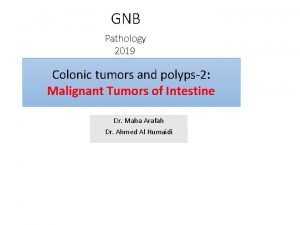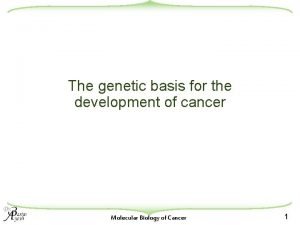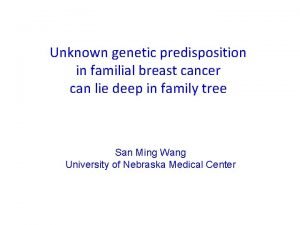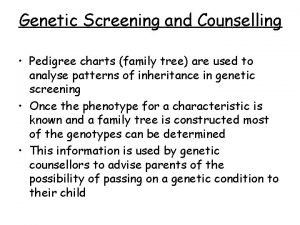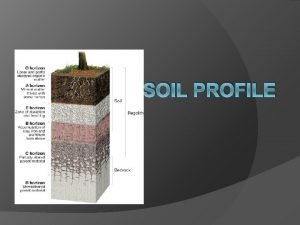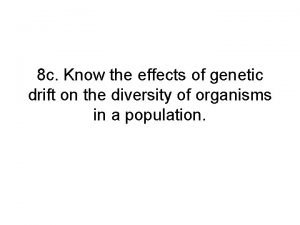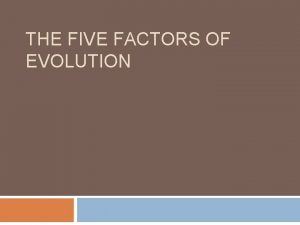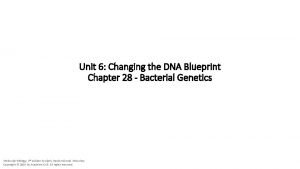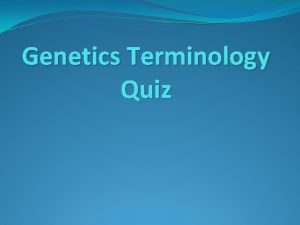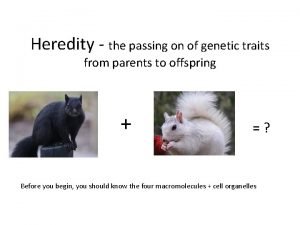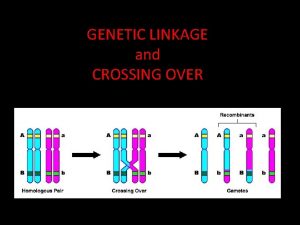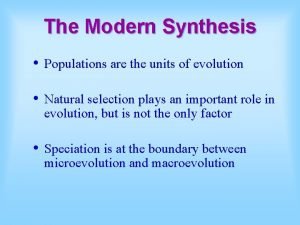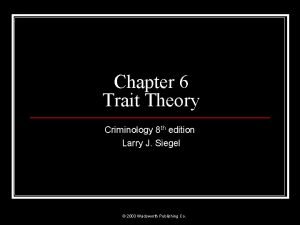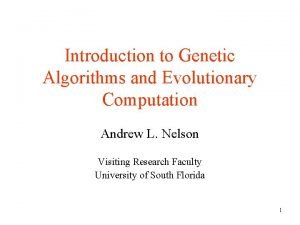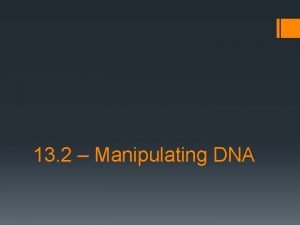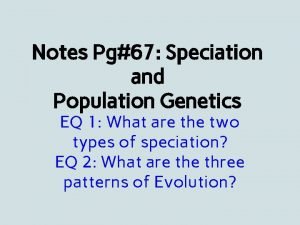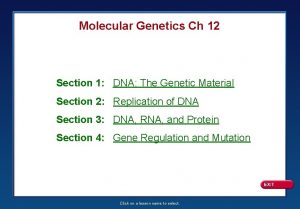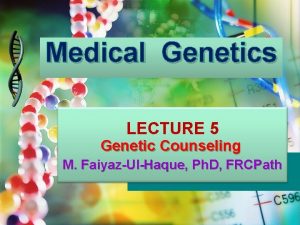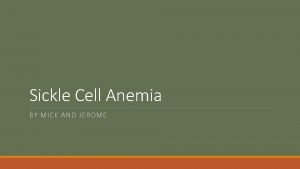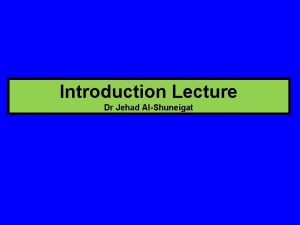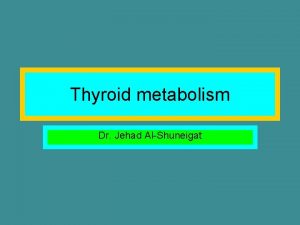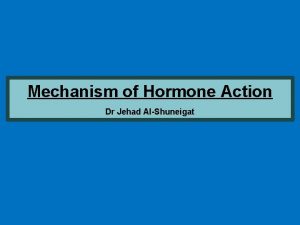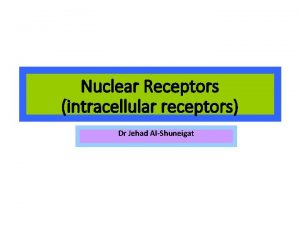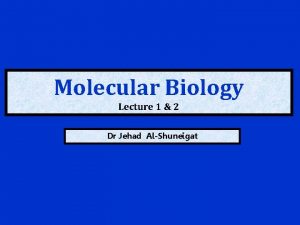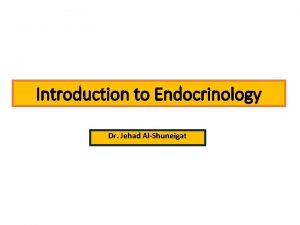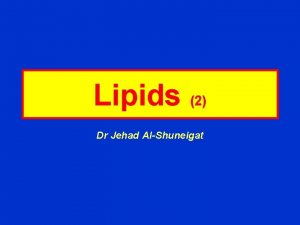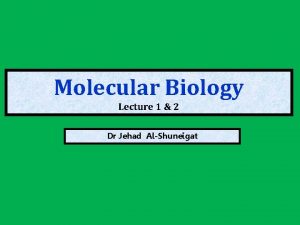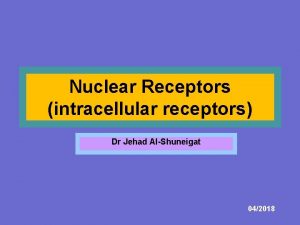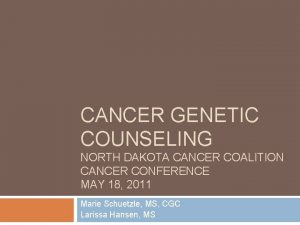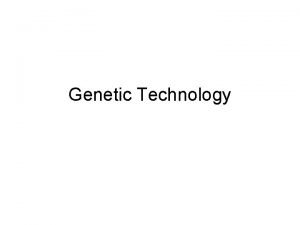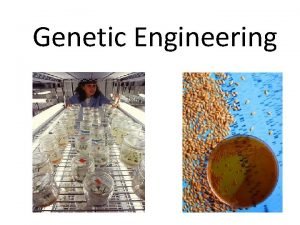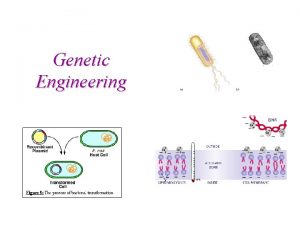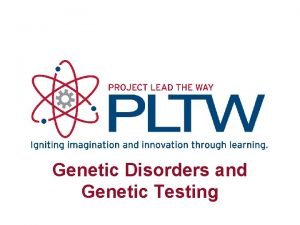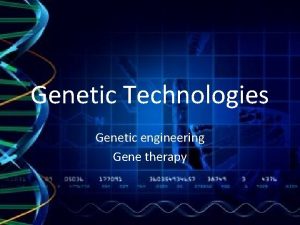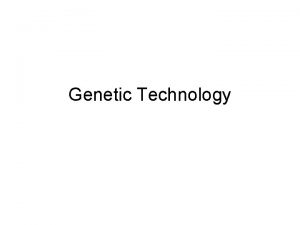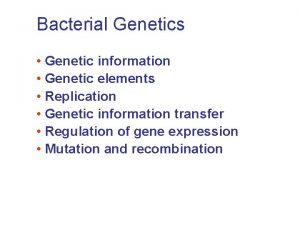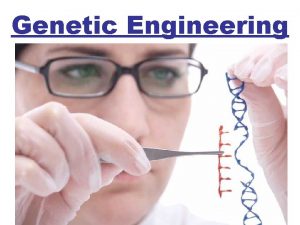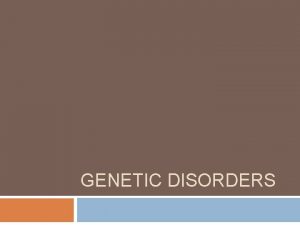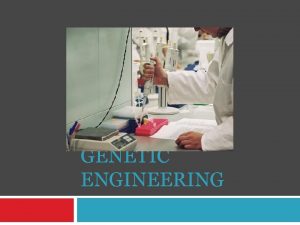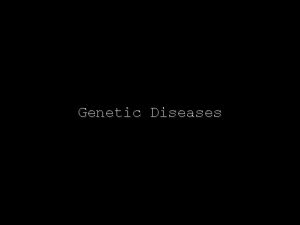CANCER Dr Jehad AlShuneigat Cancer is a genetic





























- Slides: 29

CANCER Dr Jehad Al-Shuneigat

• Cancer is a genetic disease characterized by uncontrolled cell division and metastasis. • There are two types of tumours. 1. The first type known as cancer or malignant tumour is characterised by invasiveness and metastasis. 2. The second type known as benign or non-cancerous tumour is localised. • Tumours are monoclonal growth rather than polyclonal. Biochemical and genetic markers studies on tumour populations show that cells in a tumour populations are identical. • It is believed that between 2 -6 genes mutations are required for a cell to be transformed to malignant ones. • Many cancers form solid tumors while others do not form solid tumors like cancers of the blood, such as leukemias. •

• Normal human cells undergo the following alterations to be transformed into malignant cancer cells: • (1) Generation of own growth signal • (2) Resistance to growth inhibition • (3) Ability to escape apoptosis • the life or death of a cell relies on signals received through survival receptors such as IGF-1 R and IL-3 present on the surface of the cell and the death receptors FAS and TNF. Disruption of the FAS death receptors and mutation of p 53 and other tumour suppressor genes play a crucial role in the cancer cell avoiding apoptosis. • (4) Uncontrolled proliferation, resistance to growth inhibitor, the ability to generate their own growth signal and escape of apoptosis, all lead to uncontrolled proliferation of cancer cells. • (5) Induction and sustainment of angiogenesis, the process of formation of new blood vessels in a tumour is known as angiogenesis. Angiogenesis is important for delivery of nutrients to tumour cells and progression of a pre-malignant lesion to a fully invasive tumour.

• The process of angiogenesis can be divided into four stages: • In stage 1, the latent tumour makes the angiogenic switch. • In stage 2, when the size of the tumour reaches 0. 5 to 1. 0 mm in diameter it starts producing growth factors such as vascular endothelial growth factor which activates the endothelial cells (barrier between vessels and tissue and living adjacent to blood vessels). Once activated the endothelial cells start to proliferate and migrate towards the tumour. • In stage 3, endothelial cells sprout to develop into endothelial tip cells. • In stage 4, the sprout forms a lumen and the tumour becomes connected to the vascular system.

Angiogenesis

(6) Metastasis and invasiveness: Metastasis refers to the ability of the cancer cells to spread away from the primary tumour and invade other parts of the body. • There are two main events in metastasis. 1 - The first involves changes in attachment of cells 2 - Activation of extracellular proteases that degrade the extracellular matrix (ECM). • Cells produce adhesion substances including 1 -The integrins is involved in cell to ECM interaction whereas 2 -The cadherins is involved in cell to cell interaction. Cadherins are mutated in most of the epithelial cancers and this plays a crucial rule in enhancing invasiveness and metastasis. The activation of extracellular protease facilitates the invasion of cancer cells by promoting degradation of ECM.

• Cancer cells characteristics: • Tumour cells differ from normal cells in a number of characteristics including: (1) Cell size: Tumour cells are either abnormally large or abnormally small compared to normal cells, (2) Nuclear size: Nuclear size in tumour cells is much larger than that in normal cells and it has irregular chromatin distribution, (3) Ability to grow in suspension: Unlike normal cells the tumour cells are able to grow in suspension (4) Specialization: Cancer cells are less differentiated than normal cells. Thus cancer cells are less specialized than normal cells with no specific functions.

The risk factors for cancer include 1 - Environment 2 - Hereditary. It is estimated that environmental factors are responsible for 80%-90% of cancer v About 5 -10% can be related to inherited genes. v Environmental factors include smoking (30%), diet (30%), infection 15 -20% and the remaining is due to radiation, stress, environmental pollutant etc. v It is estimated that about two third of cancer can be prevented through changes in life style including avoidance of smoking and drinking, and dietary alterations.

Viruses and cancer It is believed that cervical carcinoma, hepatomas (liver cancer), some head and neck cancer, kaposi’s sarcoma (herpesvirus 8 (HHV 8)) , some anal cancers, and Burkitts lymphoma are caused by viruses. 99. 7% of cervical tumours have fragments of papilloma virus genome integrated to the host cell genome. The virus can cause direct oncogenetic changes by numerous mechanisms including: Ø Providing oncogenes to a normal cell Ø Inhibiting tumour-suppressor gene function Ø Enhancing DNA damage Ø Inhibiting apoptosis of damaged cells Ø Interfering with DNA repair mechanisms Ø Resisting host organism immune effector mechanisms.

Cancer Genetics 1 - Proto oncogene and oncogene • Proto-oncogenes normally promote cellular growth and differentiation. • When cell growth is completed, proto-oncogenes are turned off. • Oncogenes are the mutated forms of proto-oncogenes that promote overproduction of growth factors or increase their activity. Oncogenes also disrupt the activity of cyclins and cyclin-dependent kinases (CDKs); disruption of cyclindependent kinases distracts the cell cycle checkpoint leading to uncontrolled cell division of the mutated cells.

• Proto-oncogenes and oncogenes • Proto-oncogenes get converted to oncogenes through mutation and gene amplification and translocation. • The most common inducers of mutation are viral infections and chemicals. • Gene amplification occurs when a certain region of the chromosome undergoes several rounds of DNA synthesis in the same cell cycle. Cancer has always been found to be associated with amplifications of oncogenes. For example, ERBB 2 amplification is always found in breast and ovarian cancers. • Translocation may lead to changes or lack of control of expression (promoter and enhancer). For example, in Burkitt’s lymphoma MYC oncogene initially found at chromosome 8 is translocated to chromosome 2, 14, or 22.

• 2 - Tumour suppressor genes • Tumour suppressor genes regulate many functions in cells including cell cycle, recognition of DNA damage and its repair and protein degradation. • In tumour suppressor genes, only one allele of the gene pair is enough to function as a suppressor. This means that to lose suppressor function both alleles of a tumour suppressor gene pair have to be mutated. The most known and studied tumour suppressor gene is p 53.

• Tumour suppressor genes p 53 • p 53, often called the guardian of the genome • p 53 protein is made up of 393 amino acids and is not important for cell growth or development. • The main role of p 53 in the cell is to regulate the cellular response to internal and external stress signals through regulation of cell cycle arrest and apoptosis. p 53 regulate cell cycle checkpoints, differentiation, and DNA repair. • There are many internal and external stress signals that activate p 53 including DNA damage, metabolic change, cell-cell contact, and activated oncogenes. • • p 53 is the most mutated gene in human cancer. It has been found that p 53 has 75%-80% mutations or abnormalities in colon tumours alone and between 50 -60% of all human cancers. Mutations in p 53 lead to survival of cells with damaged DNA that may lead malignant transformation

Cancer Diagnosis 1. Biopsy: This involves taking a sample of tissue from a potentially cancerous lesion and examine the cells for signs of cancer. 2. Imaging scans: Examples: CT, ultrasound, or MRI scan. 3. Tumor markers: Cancerous cells release compounds into the blood. Lab tests can confirm a diagnosis. Ø Alpha-fetoprotein (AFP) used as a marker for Liver cancer Ø Bladder Tumor Antigen (BTA) used as a marker for Bladder cancer and cancer of the kidney

Cancer treatment • Currently cancer is curable and preventable in many cases. • Cancer is treated by surgery, radiation, Immunotherapy, hormone therapy and chemotherapy beside other ways. The choice of treatment depends on cancer stage, type, treatment success, and patient’s age and health. • Staging is a system that defines the extent of cancer spread. It is an important step in the management of cancer as it will determine the type of treatment needed. • The Tumor Node Metastasis (TNM) staging system classify tumour into three categories T, N, & M: (1) T represents the extent of primary tumour. It is divided into T 1, T 2, T 3 and T 4 depending on the extent of cancer. T 4 is considered a massive lesion and in general it is hard to treat. (2) N represents the effect of cancer on lymph nodes. It is sub-classified in to N 0, N 1, N 2 and N 3. In N 3 the lymph nodes are fixed by the tumour to surrounding structures. (3) M stands for metastasis. Presence of metastases is indicated by M+ and its absence is indicated by M‒

Another staging system that is used for all types of cancer groups the cancer into five main categories. Stage What it means Stage 0 Abnormal cells are present but have not spread to nearby tissue. Stage I, Stage II, and Stage III Cancer is present. The higher the number, the larger the cancer tumor and the more it has spread into nearby tissues. Stage IV The cancer has spread to distant parts of the body.

Cancer treatment 1. Surgery • Surgery is the cornerstone of treatment for most solid cancers that are confined to the organ of origin. However, it may not deal with micrometastatic disease and therefore chemotherapy or radiotherapy is often given before or after definitive surgery. 2. Radiation Therapy (Ionizing Radiation) • DNA is the main target of ionizing radiation. Ionizing radiation can also damage water molecules in cells leading to the formation of reactive oxygen species (ROS). ROS produced cause DNA damage including strand breakage and loss of nucleobases. DNA damage leads to cell death through apoptosis or necrosis. One of the disadvantages of ionizing radiation is that it may kill both normal and cancer cells. However, the physiological differences between cancer cell and normal cell and advances in radiation therapy (such as Intensity Modulation Radiotherapy Technique abbreviated as IMRT’s) have made it possible to specifically target tumour cells while leaving normal cells largely unaffected. • Clinical radiation is divided into two categories: • (1) Curative therapy is applied to patients who have a chance of making full recovery. • (2) Palliative therapy is applied to patients with incurable disease. The main aim is to minimize cancer symptoms and improve quality of life.

• 3. Immunotherapy to Treat Cancer • Boost body’s own immune system to prevent, control, and eliminate cancer through the use of many substances. • Types of immunotherapy: • A. Monoclonal antibodies: are lab made antibodies that bind to specific antigens on targets cancer cells. • B. Oncolytic virus therapy: the use of modified viruses to destroy cancer cells. • C. T-cell therapy: T-cell is a type of immune system cell. The patient's T cells are genetically engineered to express chimeric antigen receptors (CARs) on their surface. CARs are proteins that allow the T cells to recognize an antigen on targeted tumor cells.

• Continue Immunotherapy to Treat Cancer • D. Cancer Vaccines Cancer vaccines: of two types: • Preventive Cancer Vaccines • It is made from weakened or dead form of a germ to help your immune system develop immunity. • Cervical cancer and head and neck cancer can be caused by human papilloma virus, liver cancer can be caused by hepatitis B virus. Vaccines have been developed that can prevent human papilloma virus and hepatitis B virus. • Therapeutic Cancer Vaccines • Help forcing the immune system to recognize a virus or cancerous cell. Example: the use of specific cancer antigens to force the immune system into action.

• 4. hormone therapy: • Some cancers depend on hormones to grow thus block or alter hormones can sometimes help slow or stop the growth of these cancers. Hormone therapy is mostly used to treat certain kinds of breast cancer and prostate cancer that depend on sex hormones to grow. • Hormone therapy works through: Ø Stop the body from making the hormone Ø Block the hormone from attaching to cancer cells Ø Alter the hormone so it doesn't work like it should Ø Eliminate the hormone receptors on cells or change their shape

• • 5. Chemotherapy involves the use of drugs to kill malignant cells. Chemotherapy works in many different ways including interacting with DNA, binding to cellular proteins such as tubulin, and interacting with DNA associated proteins such as topoismerase. The effectiveness of chemotherapy can vary widely among patients due to differences in genetic make-up. 1 - The first antitumour chemotherapy used was alkylating agents in 1940 s. Examples of alkylating agents include nitrogen mustard. The mechanism of action of mustard gas is believed to be similar to that of platinum drugs. 2 - Antimetabolites such as 6 -mercaptopurine (6 -MP) were developed to kill cancerous cells in 1952; the drugs are still in use. The compounds mimic some crucial compounds needed by cells for example nitrogen bases to build DNA and RNA molecules. This would inhibit the early steps of DNA and RNA synthesis and as a result will stop or slow down the growth of tumour cells. 3 - Natural products from land marine environments. (a)- Taxanes were obtained from the bark of the Pacific Yew tree the active ingredient of taxanes which is known as Paclitaxel and is very effective in the treatment of ovarian cancer. Paclitaxel stabilizes microtubule assembly and thus inhibits cell division. (b)- Camptothecins is derived from a Chinese ornamental tree, it inhibits topoisomerase I enzyme that allows DNA unwinding. Camptothecin (irinotecan) is approved for treatment against colon cancer.

Example of anticancer drugs Platinum anticancer drugs: cisplatin

Binding of cisplatin to DNA: types of cisplatin adduct

Side effects of chemotherapy cisplatin as example • It is believed that toxic effects due to cisplatin are mainly due to its reaction with cellular protein and extracellular enzymes. The major toxicities associated with cisplatin treatment include: (1) Nephrotoxicity (kidney damage): 20 -41% of patients treated with cisplatin has nephrotoxicity. Cisplatin is excreted through the kidney. Therefore, cisplatin will accumulate in kidney in high concentrations. This may cause apoptosis or necrosis in these cells that may lead to kidney damage. (2) Ototoxicity (hearing loss): It is estimated that 23 -50% of adult patients treated with cisplatin experience ototoxicity while in children it is 50%. Treatment with platinum complexes may damage the outer hair cells of the cochlea in the inner ear. It is believed that the production of reactive oxygen species (ROS) in the cochlea leads to cell death in that area resulting in hearing loss. (3) Neurotoxicity (nervous system damage): It is estimated that 30 -40% of adult patients treated with chemotherapy experience neurotoxicity. Cisplatin treatment may cause damage to central nervous system. Cisplatin causes primary sensory neuropathy, which is characterised by decreased sensor nerve conduction velocity due to calcium channel blockage. • Other side effects that could result from cisplatin treatment include severe nausea, vomiting, diarrhoea and elevated blood pressure.

Cancer Classification Cancers are classified in two ways: 1. The type of tissue in which the cancer originates (histological type) 2. The location in the body where the cancer first developed known as primary site. Cancer classification based on histological type. From a histological point cancers are classified into six major categories: 1. Carcinoma 2. Sarcoma 3. Myeloma 4. Leukemia 5. Lymphoma 6. Mixed Types

1. Carcinoma They are formed by epithelial cells which covers the inside and outside (skin) surfaces of the body. Carcinomas are the most common type of cancer that account for 80 to 90 percent of all cancer cases. Carcinomas are divided into two major subtypes: A. Adenocarcinoma, Cancer that begins in glandular (secretory) cells. Glandular cells are found in tissue that lines certain internal organs and makes and releases substances in the body, such as mucus, digestive juices, or other fluids. Most cancers of the breast, pancreas, lung, prostate, and colon are adenocarcinomas. B. Squamous cell carcinoma, squamous cells are found in the tissue that forms the outermost layer of the skin (epidermis), the lining of the hollow organs of the body, and the lining of the respiratory, digestive tracts and urinary tract.

2. Sarcoma refers to cancer that originates in supportive and connective tissues such as bones, tendons, cartilage, muscle, and fat. Sarcoma tumors usually resemble the tissue in which they grow. Examples of sarcomas are: Osteosarcoma or osteogenic sarcoma (bone) Chondrosarcoma (cartilage) Fibrosarcoma (fibrous tissue) 3. Myeloma is cancer that originates in the plasma cells of bone marrow. Plasma cells are a type of white blood cells that secrets antibodies.

4. Leukemia also known as blood cancer that begin in the blood-forming tissue of the bone marrow are called leukemias. The disease is often associated with the overproduction of immature white blood cells. These immature white blood cells do not perform as well as they should, therefore the patient is often prone to infection. Leukemia also affects red blood cells and can cause poor blood clotting and fatigue due to anemia. 5. Lymphoma is a cancer of the lymphatic system which is part of immune system. The lymphatic system includes the lymph nodes (lymph glands), spleen, thymus gland bone marrow. 6. Mixed Types A mixed tumor is a tumor that derives from multiple tissue types. Example: carcinosarcomas which is mixture of carcinoma and sarcoma

• Necrosis: is unregulated cell death due to cell injury resulting from internal or external stresses such as injuries, chemical agents, or pathogens. • Apoptosis: is programed cell death (cell suicide) to eliminate unwanted cells or damaged cells beyond repair.
 Genetic drift
Genetic drift Gene flow vs genetic drift
Gene flow vs genetic drift Genetic programming vs genetic algorithm
Genetic programming vs genetic algorithm Genetic programming vs genetic algorithm
Genetic programming vs genetic algorithm What is the difference between genetic drift and gene flow
What is the difference between genetic drift and gene flow Cancer genetic
Cancer genetic The genetic basis of cancer
The genetic basis of cancer Cancer genetic
Cancer genetic Genetic symbols
Genetic symbols Genetic effects on gene expression across human tissues
Genetic effects on gene expression across human tissues Oaebcr horizons
Oaebcr horizons Genetic drift
Genetic drift What does gg mean
What does gg mean Gene drift
Gene drift Biobeyond unit 6 genetic blueprints
Biobeyond unit 6 genetic blueprints Dominant trait quiz
Dominant trait quiz Physical genetic traits
Physical genetic traits Linkage and crossing over
Linkage and crossing over Genetic drift example
Genetic drift example Biochemical theory of crime
Biochemical theory of crime Fitness function in genetic algorithm
Fitness function in genetic algorithm Section 13-3 cell transformation
Section 13-3 cell transformation Genetic unscramble
Genetic unscramble Speciation examples
Speciation examples Genetic engineering steps
Genetic engineering steps Molecular genetics chapter 12
Molecular genetics chapter 12 Genetic counseling definition
Genetic counseling definition Genetic recombination
Genetic recombination Sickle cell genetics
Sickle cell genetics Chapter 12 section 1: dna: the genetic material
Chapter 12 section 1: dna: the genetic material





